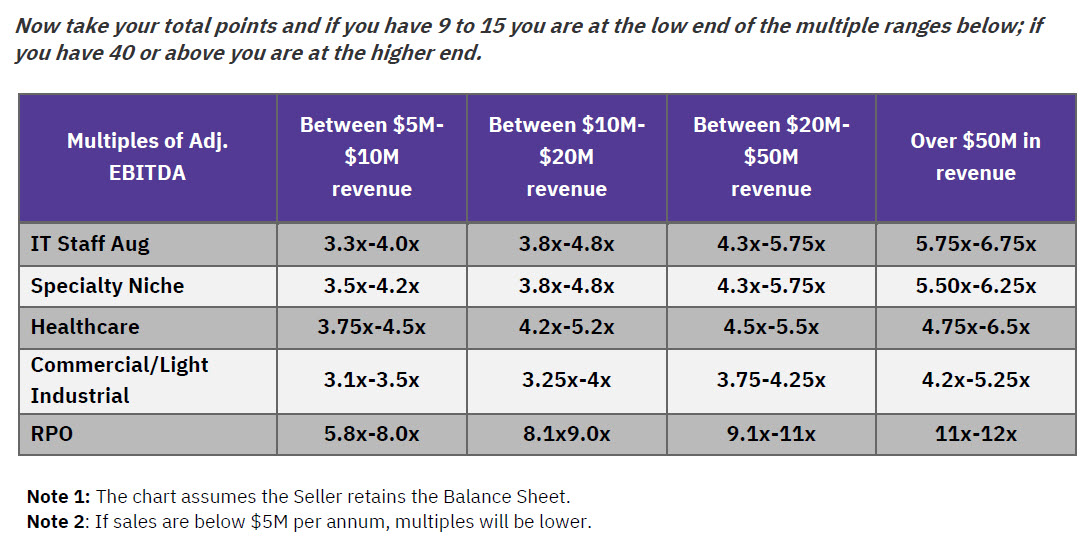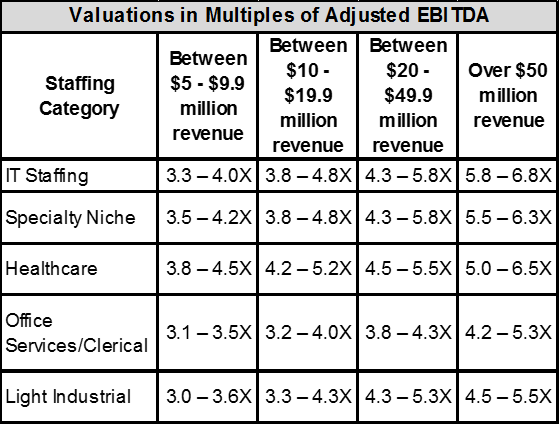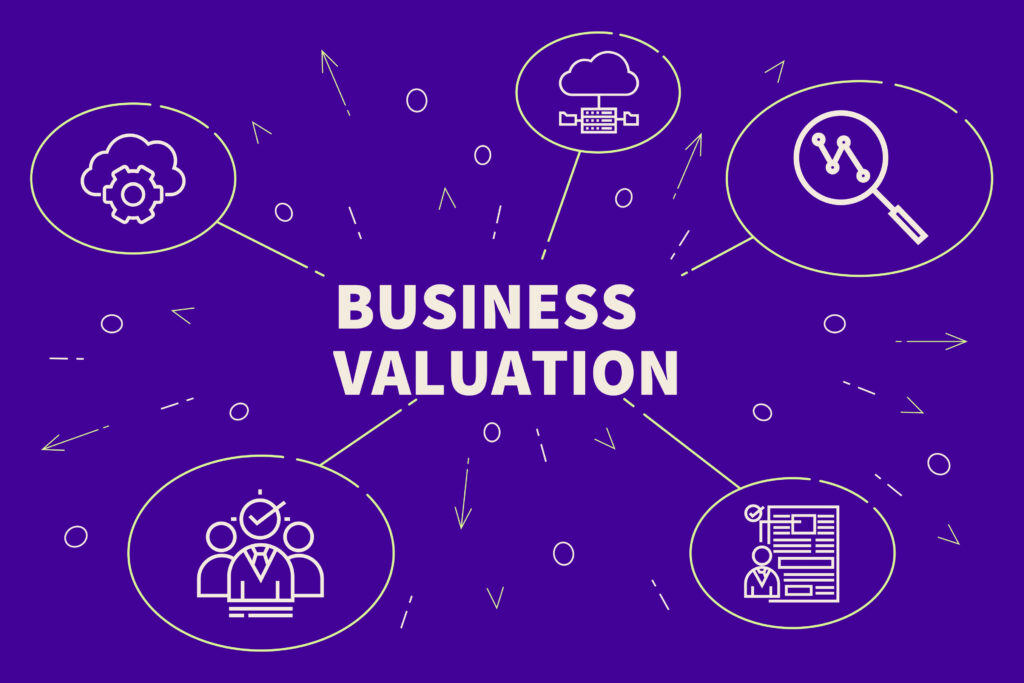What is Your Staffing Company Worth in 2024?
This article is summarized in the January/February 2024 SI Review published by Staffing Industry Analysts; however, the limited space in that format required us to edit the copy. Here is the expanded, complete article:
R.A. Cohen Consulting, with over 200 transactions completed and a team with a century of staffing and M&A expertise, has observed a shift in the M&A landscape. In 2023, economic challenges led to a decrease in staffing company acquisitions, with SIA reporting 127 US transactions in the first three quarters, compared to 221 in CY 2022.
Entering 2024, cautious optimism emerges. Buyers, equipped with substantial cash reserves, are increasingly motivated to acquire, particularly with potential economic recovery and possible easing of interest rates.
While most staffing sectors may continue to see lower market multiples, specific niches in healthcare, IT, RPO, and direct hire are experiencing higher valuations. For firms in these areas, capitalizing on current market opportunities could be advantageous. Conversely, firms facing ongoing valuation and multiple pressures might find it more beneficial to adopt a waiting strategy, potentially resulting in improved valuations and stronger market positions.
Different staffing segments and company sizes attract different buyers. Even with continued demand, some buyers at the low end of the market (those who are targeting companies under $15m in revenue or less than $750k in earnings) are taking a wait-and-see attitude. That said, we are receiving a high volume of requests from buyers for our inventory of available companies in general, and that bodes well for the year, even if multiples don’t rise.
The staffing industry maintains a positive trajectory, indicating sustained demand across various segments. Firms with higher-margin services are particularly well-positioned to command higher multiples as the market conditions improve. Up until 2023 we had several straight years of high demand and saw some multiples at their highest level in two decades. Despite the slight decline in the 2023 economy, we continue to be optimistic about M&A activity for 2024. Predictions for increased staffing growth beyond this downturn blip show investors the industry is a great place to increase their earnings.
Healthcare, Light Industrial and IT staffing continue to be the markets in focus to most current Buyers. We expect to see more interest going forward in the Accounting/Finance, Admin/Clerical, Skilled Trades and Engineering segments, given current staff shortages in many service businesses and construction-related professions.
As we said in last year’s report, staffing firms under $15m in revenue will need distinctive competencies to attract more buyers from an overall smaller pool. Examples include low-cost, effective customer/candidate acquisition metrics; great margins; niche specialty placement type, innovative technology usage, excellent MOD rate, etc. Overall, companies that the market perceives as average are likely to see lower valuations at least for the first half of 2024. The more above-average boxes you can check-off, the better your valuation will be. There are clearly some real-time examples of exceptional companies transacting at premium multiples.
To estimate your own company’s current value, use the information below to rate yourself and contact RACC to get a more detailed, personalized, complimentary back-of-the-envelope valuation.
By grading the quality of your company based on the information in this article you can roughly determine what your company might sell for in today’s market.
Begin by examining the following elements used to help arrive at a fair market value for your business. Assign a point amount for each level of performance by using a scale of 1 to 5 points.
1. High Growth Rates are always a sign of a healthy business with strong market acceptance. Since 2020, if you are growing at an annual rate of:
- 15% + per year, give yourself 5 points.
- 12% -14.9% per year, give yourself 4 points.
- 9% – 11.9% per year, give yourself 3 points.
- 6% – 8.9% per year, give yourself 2 points.
- Under 6% per year, give yourself 1 point.
2. High Gross Margins are to some degree relative to your staffing sector; certainly, a buyer wouldn’t expect the same margin level from a Light Industrial firm as they might for a Healthcare Staffing firm. Keep in mind (as an example) because of higher bill rates, GM dollars should be much higher in an IT staffing firm than they are in a Light Industrial staffing firm, even if both operate at 15% GM. So, rate yourself accordingly.
- If your gross margin is 25% or more, give yourself 5 points.
- If your gross margin is 22% – 24.9%, give yourself 4 points.
- If your gross margin is 19% – 21.9%, give yourself 3 points.
- If your gross margin is 17% – 18.9%, give yourself 2 points.
- If your gross margin is 15% – 16.9%, give yourself 3 points if you’re in IT, Engineering, or other high billing sectors;
- Give yourself 0 points if you’re in traditional sectors, such as LI, Clerical, Commercial etc.
3. Major or Growing Markets are always in greater demand by most buyers, although some buyers do prefer secondary or tertiary markets as there is often less competition.
- If you are in a top 25 market and/or a rapidly growing market, give yourself 5 points.
- If you are in a top 40 market and/or a rapidly growing market, give yourself 4 points.
- If you are in a transitioning marketplace, where some businesses are moving out to healthier markets give yourself 3 points.
- If you are in a marketplace where many of the long-term employers have
either closed, moved offshore or to areas with lower labor costs and business friendlier laws give yourself 2 points. - If you are in a town with a population of fewer than 100,000 people, give yourself 1 point.
4. Strong Market Position/Reputation is a less objective measurement than some other items we’ve listed.
- If you are a recognized market leader by customers (yours and others’) in
your market area, give yourself 5 points. - If you are an up and coming, superstar firm, getting lots of local recognition, give yourself 4 points.
- If you have had a stable presence in the market for ten or more years, give yourself 3 points.
- If you are “just there” but with very little awareness of your service in the
market, give yourself 2 points. - If you are under the radar serving a small group of satisfied clients, give yourself 1 point.
5. Diverse, Long-term and Stable Customer Base – Buyers always prefer a stable, diverse customer base:
- If you have a stable list of long-term repeat customers, especially if some or many are growing and/or your top client is no more than 12% of your total sales volume, give yourself 5 points as buyers seek stability and customer diversification.
- If you have a stable list of diverse customers and your top spending client spends between 12% – 15% with you, give yourself 4 points.
- If your top spending client represents between 15 -18% of your sales, give yourself 3 points.
- If your top two clients spend 30% or more, give yourself 2 points.
- If you have this week’s customers and you know that next week’s customers are totally different this increases the risk and the cost for the buyer; and/or if your top customer is more than 30% of your revenue, give yourself 1 point.
6. Multiple Offices are still preferred as they are perceived by buyers to spread risk. This applies to staffing firms that require a strong in-market, in-person presence (light industrial, office admin, hospitality, etc.). If your business can run on a fully remote basis give yourself 3 points. We suggest this middle-of-the-road number because fully remote businesses aren’t appealing to all Buyers.
- If you have an annual sales volume above $12M with 3 or more offices, give yourself 5 points.
- If you have annual sales of $9M with two or more offices, give yourself 4 points.
- If you have 2 offices doing $7M in sales, give yourself 3 points.
- If you have a single office doing over $5M, give yourself 2 points.
- If you have one office billing less than $5M, give yourself 1 point.
7. Annual Sales Volume – Size in terms of annual sales volume adds value to the buyer, all things being equal (e.g.: GM% and bottom-line profitability). There are no points allocated here; the chart at the end of this document takes this into consideration.
8. Good management depth is extremely important to a buyer so they can see the business can be managed after the seller’s exit.
- If you have solid, experienced line management operating your business that will stay on and grow the business, give yourself 5 points.
- If you have young, sharp, aggressive, keen but less experienced staff that will stay on and contribute to the firm’s on-going growth, give yourself 4 points.
- If you have a solid crew of performers that can maintain the business, give yourself 3 points.
- If you have one or more weak links or vacancies in an important functional staff/management area, give yourself 2 points.
- If the owner is the key to the business and the buyer will need to install a
manager(s), give yourself 1 point.
9. Good Insurance, a clean legal history and accurate record keeping build confidence in buyers.
- If you have declining WC incidents and/or fewer SUTA claims, combined
with books of account that add up properly, give yourself 5 points. - If your books balance and insurance claims are steady, give yourself 4 points.
- If your books balance and your insurance claims are in line with industry numbers, give yourself 3 points.
- If your insurance claims are in line but your books don’t balance, give yourself 2 points.
- If your WC losses or SUTA claims are increasing and if your books are not totally reliable give yourself 1 point.
10. More Contract/Temp Staffing vs. Perm/Search Revenue improves value because contract and temp revenues are more stable and predictable than Search or Direct-hire revenues.
- If your Search/Direct Hire business is less than 5% of your annual revenues, give yourself 5 points.
- If your Contract/Temp business volume is 90% or more, give yourself 4
points. - If your Contract/Temp business is growing in proportion to your Search/Direct Hire business, give yourself 3 points.
- If your Search/Direct Hire business exceeds 15% of your annual revenues, give yourself 2 points.
- If your sales in Search/Direct Hire exceed 20% of your annual business
volume, give yourself 1 point.

Heading Text
There are always exceptions to the ratings above, if you would like a confidential analysis of your market value contact:
Sam Sacco (910) 769-4057 or sam@racohenconsulting.com
Brian Kennedy (416) 229-6462 or brian@racohenconsulting.com
Mark Zacha (616) 318-7979 or mark@racohenconsulting.com
www.racohenconsulting.com
This is a © work product of R. A. Cohen Consulting and may not be distributed or reproduced without their express written consent.










